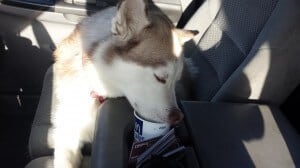Train Your Dog to Sit in 7 Steps
Why train sit?
Every dog should have one command she can do anywhere, anytime. Sit is a great contender for that job. It gives your dog a way to say, “Please,” and can become her default greeting, which helps stop her from jumping on people.
How to train it.
Step 1. Capture it. Sometimes, we can simply wait for a dog to sit on his own, because it is a very natural behavior. If you happen to catch a dog moving into the sit position, mark the behavior and reward.
Alternatively, lure your dog into a sit by allowing him to lick at a treat in your hand while you move your hand and the treat slowly over her head toward her tail. Keep the treat lure close to your dog’s nose—if you move your hand up too quickly or too far away from her mouth, she may give up and lose interest.
Step 2. Pay it. As soon as your dog’s hindquarters hit the ground click and toss the treat so your dog has to stand up to retrieve it.
Step 3. Repeat it. Repeat three times.
Step 4. Fade it. Take the treat out of your hand and repeat step 1-3 without the food lure. Do this until your dog sits reliably using only a hand signal without you holding the food in your hand.
Transfer the Cue. You may use the hand cue as the permanent cue to get your dog to sit (which is my favorite as I can get my dog to sit without saying a word), or you may wish to teach your dog a word or other sound (like the doorbell, hint, hint) means you want them to sit. If so, go to Step 5.
Step 5. Say it. Tell your dog, “Sit” in a cheerful tone of voice then give the hand cue. When your dog sits, click and reward. Repeat this step three times.
Step 6. Fade the hand cue. Say the word “Sit” then pause a second (one-one thousand), then use the hand signal, if necessary.
Step 7. Pay it again. As soon as your dog’s hindquarters hit the ground click and treat.
Training Tip: Be sure to pause in between saying the cue and using the hand signal to cue your dog into a sit. If you do both at the same time (called overshadowing), your dog might not ever learn the word by itself—and you will be stuck giving two cues instead of just one.
Training Tip: Only say the word once for each time you give the hand signal. If you say the cue but your dog won’t sit without the hand cue, do not repeat the word “Sit”. Simply shorten the pause between the hand cue and the word cue.
When to practice: Before throwing a ball, Frisbee, rope-toy, etc. Before giving your dog a toy. Before putting the food bowl down. Before handing over a treat or chewie. Before opening a door. Before putting on a leash to go for a walk. Before taking off a leash at the park or beach. Etc.





